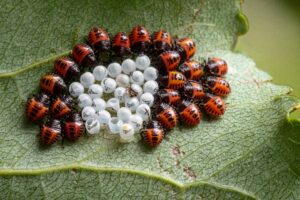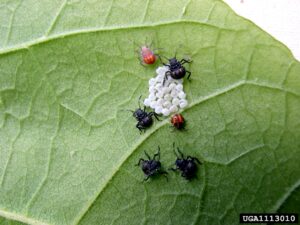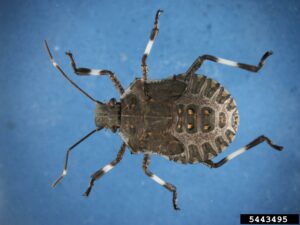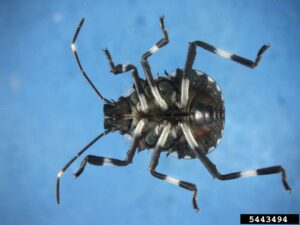It’s Brown Marmorated Stink Bug season – are you prepared?
The Brown Marmorated Stink Bug (BMSB) is a significant plant pest that affects multiple vegetable commodities, causing crop damage, affecting marketability, and reducing yield.
What is it?
The Brown Marmorated Stink Bug (BMSB) (Halyomorpha halys) is a shield bug insect native to China, Japan, Korea and Taiwan. It was accidentally introduced to the USA and rapidly established in the 1990s and throughout parts of Europe. The pest is a seasonal hitchhiker associated with imported cargo from the northern hemisphere but is sometimes found in the luggage of returned travellers. The southern regions of Australia are particularly at risk of potential establishment.
As we approach the seasonal risk period for this nuisance ‘hitchhiker,’ Front Line discusses why this pest threatens Australia’s vegetable industry, what to look out for and how to report the pest.
Why should I be worried?
BMSB feeds on more than 300 plant species, including vegetable crops such as sweetcorn, capsicum and okra, as well as asparagus, green beans, eggplant, cucurbit and cruciferous species. Outbreaks can be challenging and expensive to manage, with pests not easily eliminated using pesticides. It is currently a top priority for industry, sitting at number nine on the list of National Priority Plant Pests.
Damage and yield loss caused by BMSB varies among host species. For example, they can physically injure fruiting crops like capsicum and feed on leaves, creating entry points for diseases. In sweetcorn, the bug can pierce through the husk and suck out the juice in corn kernels, leaving the kernels shrivelled and unmarketable.
In urban areas, BMSB is considered a nuisance pest. In the colder months when it goes into hibernation, it seeks shelter in artificial structures such as cracks and crevices in buildings, vehicles, all sorts of packaging, and many more. It will not cause structural damage to the building, but its high infestation numbers of hundreds or thousands are problematic. When disturbed or stepped on, it releases an unpleasant odour similar to ammonia and/or sulphur.
What does it look like?
The Brown Marmorated Stink Bug has a brown, shield-like shape. Adult bugs are about the size of a five-cent coin – 12 to 17mm in length and 7 – to 10mm in width – and are brownish, marbled or a mottled colour with a faint reddish tinge. One of the most distinctive features of BMSB is the white banding present on the antennae, sides of its abdomen and legs.
Eggs are barrel-shaped, about 1.6mm long and light green to white. They are laid in clusters of 25 to 30 on the underside of the leaves.
BMSB eggs and early instars
Young, newly hatched nymphs have dark red eyes and a yellowish abdomen mottled with black and red. There are five nymphal instars, and the nymph becomes darker with each moult. It also starts developing the characteristic black and white bands on legs and antennae.
BMSB late instar nymph
Insect Life Cycle
The BMSB undergoes incomplete metamorphosis, with young nymphs resembling adults. There is no pupal stage. Adult females lay eggs, from which first instar nymphs hatch. These nymphs go through five stages of growth, shedding their exoskeleton each time until reaching adulthood.
In warmer climates, females may lay multiple egg clusters, allowing for several BMSB generations per year. In cooler areas, there are typically 1-2 generations annually. Adult BMSBs enter winter diapause as days shorten, and dormancy is broken in spring with increasing day length and temperatures.
What can it be confused with?
Many native Australian stink bug species have evolved alongside Australian flora and are not considered pests. Their natural enemies control these species. However, some stink bug species are not currently present in Australia. Identifying the brown marmorated stink bug (BMSB) can be tough. Look for white and black banding around the abdomen and distinctive banding around the legs and antennae. Note that these features are common in other stink bug species too!
How will it get there?
This pest is a frequent hitchhiker, traveling internationally on or inside cargo like machinery, vehicles, and sea containers. Although it doesn’t naturally occur in Australia, it can spread rapidly and has a wide range of hosts. It can fly up to 2km per flight.
Seasonal surveillance – Biosecurity measures
Australia is most at risk of a BMSB incursion from goods shipped between September 1 and April 30. This aligns with the bugs’ hibernation period in the northern hemisphere. The bugs seek shelter in cargo, which may lead to an incursion in Australia when they awaken. During this seasonal surveillance window, certain goods produced in or shipped from target high-risk countries (countries where BMSB has established) are subject to mandatory biosecurity inspections upon arrival in Australia.
CSIRO and DAFF have developed and trialled a mobile device application that uses artificial intelligence to identify and distinguish BMSB and other exotic stink bugs from native Australian species. This technology aims to speed up the biosecurity inspection process for arriving international cargo.
What can I do?
This pest must be reported immediately through the Exotic Plant Pest Hotline, which can be reached 24/7 on 1800 084 881.
Exotic Plant Pest Hotline Logo
For further details on AUSVEG’s biosecurity activities, please get in touch with the AUSVEG Biosecurity & Extension team on 03 9882 0277 or email science@ausveg.com.au.
The Farm Biosecurity Program is funded by the Plant Health Levy.





